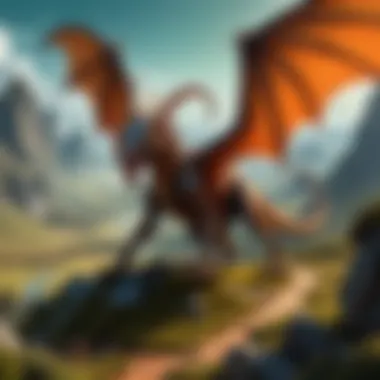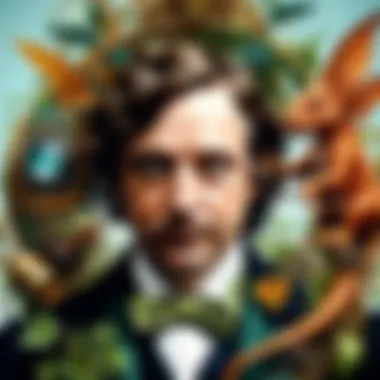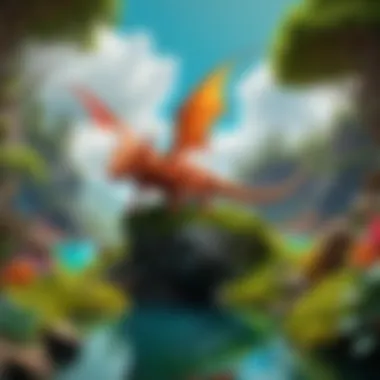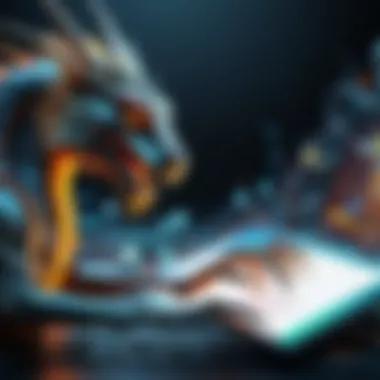Exploring Jabberwocky: Lewis Carroll's Poetic Innovation


Intro
Lewis Carroll’s poem Jabberwocky is much more than a playful string of nonsensical words. It has, over time, become a fascinating study for literature enthusiasts and linguists alike. At first blush, the whimsical language draws readers in with a sense of wonder. But as one ventures deeper into its stanzas, the layers of meaning and artistic brilliance begin to reveal themselves. This article aims to be a comprehensive guide to understanding this literary gem, examining its background, the unique techniques employed in its construction, and exploring its long-lasting influence on both literature and popular culture.
In examining Jabberwocky, we will reflect on the playful use of language that defies traditional rules, thus inviting readers to find their own interpretations. Speaking to both the historical context that birthed this piece and the contemporary relevance it holds today, we find a treasure trove of insights waiting to be uncovered. Dive in as we embark on this journey through Carroll's captivating and curious world.
Preamble to Jabberwocky
In the realm of poetry, few works evoke as much fascination and intrigue as Lewis Carroll's Jabberwocky. Nestled within the pages of Through the Looking-Glass, this whimsical piece stands out, not just for its playful use of language, but for the depth and complexity woven through its verses. Understanding Jabberwocky is crucial for several reasons. It’s not merely an engaging poem; it serves as a gateway into the mind of Carroll, illuminating his childlike perspective mixed with profound creativity.
The poem is unique in how it toy with our expectations of language. With its portfolio of nonsensical words, Jabberwocky invites readers into a linguistic playground where traditional rules are set aside. It's a testament to the idea that meaning can be contextually constructed, even from fragments of sound that otherwise might seem meaningless. This presents an engaging challenge for readers and scholars alike, who strive to decode its hidden messages and playful insights.
Through this examination, the layers of Jabberwocky unfold, revealing not only the historical backdrop that shaped it but also its influence on literary traditions and modern interpretations. From the whimsical terror of the Jabberwock itself to the whimsical and perplexing language that dances across the stanzas, this poem mirrors the tumultuous struggle between imagination and reality. It encourages us to reconsider how we perceive language, creativity, and storytelling.
In diving into Jabberwocky, we’ll embark on a multifaceted exploration of its history, structure, language, and thematic elements, offering a comprehensive look at why this peculiar poem continues to captivate audiences decades after it was written.
Structure and Form
The structure and form of Jabberwocky are integral not just to the poem's whimsical charm but also to its broader thematic resonance. To fully appreciate Lewis Carroll’s ingenuity, one must analyze how the arrangement of stanzas, the rhyme scheme, and the narrative progression work hand in glove to create an immersive experience.
Stanza Breakdown
Carroll’s poem consists of a series of stanzas crafted with precision. Typically, it features six stanzas that vary in imagery and thematic depth. Each stanza operates almost like a mini-story, encapsulating a unique aspect of the protagonist’s experience. The first stanza introduces the setting and the looming threat of the Jabberwock, setting a tone of whimsical dread.
Here's a closer look at the elements of these stanzas:
- Introduction: The first stanza typically paints the backdrop—a fantastical world brimming with peculiar creatures.
- Conflict: In subsequent stanzas, we see a shift where the protagonist encounters danger, echoing classic heroic tales. This aspect creates tension.
- Resolution: The concluding stanzas typically resolve the conflict, adding a sense of unity to the poem.
This careful layering makes like a finely woven tapestry, where each thread plays a vital role, culminating in a rich narrative texture. It’s clear that Carroll expertly crafted the stanzas to carry the reader along the arc of adventure, evoking both curiosity and suspense.
Rhyme and Meter Analysis
The rhyme in Jabberwocky is not arbitrary; it is part of Carroll’s artistic choice that heightens its musicality. Adopting a pattern of alternate rhymes, Carroll employs a consistent AABB structure throughout the poem. This rhythm contributes to its catchy and sing-song quality, making it memorable.
Consider the following benefits of this rhyme scheme:
- Engagement: The catchy melodies draw readers in, inviting them to explore the poem deeply.
- Balance: A structured rhyme adds balance to the chaos of nonsense words; it provides an anchor.
- Dynamics: The interplay of sound enhances the emotional weight, particularly in climactic moments, where the rhythm quickens and stirs anticipation.
The meter typically follows a mix of iambic and anapestic foot, lending a certain fluidity. This musicality becomes a form of language play in itself, engaging the reader's auditory senses while communicating complex ideas through seemingly nonsensical phrases.
Narrative Arc and Progression
A critical aspect of Jabberwocky is its narrative progression. Carroll employs a straightforward yet effective narrative arc, mirroring the classic hero’s journey, which many readers identify with instinctively. The transformation from the mundane to the fantastic represents a deeper philosophical inquiry into courage and the quest for identity.
The stages can be outlined as follows:
- Departure: The hero leaves a familiar world, entering a realm of absurdity. This could symbolize a larger journey into self-discovery.
- Challenge: Confronting the Jabberwock becomes a pivotal moment; it’s a metaphor for facing one's fears.
- Victory and Return: The eventual triumph showcases personal growth, drawing attention to themes of bravery and metamorphosis.
This narrative might seem simple at a glance, yet it resonates with multiple layers of meaning. Carroll's choice to follow a conventional structure amid the riot of nonsense enables readers to engage with the text on both an intellectual and emotional level, enriching the overall experience of Jabberwocky.


"Nonsense words, while they may appear devoid of meaning, serve a greater function in evoking emotional responses and stimulating imagination."
In sum, the structure and form of Jabberwocky are not just stylistic choices; they facilitate a profound interaction with the text, compelling readers to navigate its depths and unearth hidden interpretations.
Language and Lexicon
Understanding the intricacies of language and lexicon within Jabberwocky offers a vital insight into its lasting complexity and charm. This section highlights how Carroll employs a unique set of words, which at first glance may seem nonsensical. Yet, these choices serve a purpose, enriching the text and allowing readers to explore deeper meanings. Language not only conveys surface-level whimsy; it encapsulates human experience and emotion in multifaceted ways, transforming what could have been an ordinary poem into something enchanting and thought-provoking.
Nonsense Words and Their Impact
Lewis Carroll’s Jabberwocky is a treasure trove of nonsense words, serving as a backbone to its whimsical nature. Words like "slithy" and "tove" might sound perplexing, yet they resonate with the reader's imagination. These invented terms can evoke vivid imagery without adhering to traditional grammar or meaning, which presents a captivating challenge.
The impact of these nonsense words is profound. They compel the audience to engage creatively with the text, requiring interpretation beyond mere dictionary definitions. For instance, the term "frumious" captures an emotional state of fury mixed with curiosity, inviting speculation about its meaning in the context of the poem. This ambiguity fosters a sense of playfulness, aligning perfectly with the overall tone of the work. The virtually infinite interpretations of these phrases encourage readers to experience the poem rather than merely read it, enhancing personal connections to the text.
Phonetic Qualities and Sound Devices
Phonetics play a crucial role in Jabberwocky, where sound devices are strategically placed to create a musicality that complements the poem's themes. When we examine the phonetic qualities of words like "callooh" or "callay", we notice they are not mere distractions but integral to the poem’s rhythm and flow. It's as if Carroll knew that every syllable had to dance off the tongue, drawing readers into a fantastical world.
The melodic quality of the language invites recitation, and with it, a deeper immersion into the narrative. By deploying alliteration and assonance, the poem resonates sonically. For example, the repetition of the initial consonant sounds in phrases brings forth a delightful cohesion that pulls you along the verses. This intricate balance of sound ensures that Jabberwocky exists not just on the page but in the auditory realm, creating a richer reading experience for those willing to listen closely.
Linguistic Creativity in Jabberwocky
Carroll's adept play with language showcases his linguistic creativity, manifesting in various forms throughout Jabberwocky. He doesn't merely invent words; he constructs entire phrases that defy conventional logic. This transformation of the English language, much like a skilled craftsman with tools, allows him to bend and twist it into shapes that evoke feelings and imagery that resonate on different levels.
Take the phrase "the jaws that bite, the claws that catch" — through exquisite alliteration, this language doesn’t just describe the Jabberwock but also evokes a visceral response. Readers can “feel” the danger lurking in this creature.
This linguistic experimentation invites scholars and readers alike to consider what language can achieve, pushing boundaries typically imposed by grammatical norms. It inspires ongoing discussions about the potential of language and creativity. Carroll's innovative approach ensures that Jabberwocky is not just a poem to be read but an experience to be lived.
In Jabberwocky, every word, even the nonsensical, serves to expand the horizons of language, offering a rich playground for the imagination.
The beauty of Jabberwocky lies in its ability to create a community of readers who share their interpretations and experiences, each uniquely colored by their lens. Thus, Carroll’s whimsy transforms into a profound exploration of language—celebrating its potential and its limitations.
Thematic Exploration
The thematic exploration of Jabberwocky serves as an essential prism through which readers can decipher the intended meanings embedded in Lewis Carroll's whimsical verses. The poem not only showcases playful language but also grapples with profound themes that resonate with the human experience. As we dissect the thematic elements, a clearer understanding emerges about how Carroll ingeniously weaves together narrative motifs that transcend mere nonsense.
The Hero’s Journey
At its core, Jabberwocky echoes the classic Hero's Journey, a framework commonly found in literature. The protagonist sets off on a quest, armed with courage and a sense of purpose. This structure mirrors the contours of traditional epics, yet its substance is drenched in absurdity. The young hero learns of the fearsome Jabberwock, a symbol of chaos and disorder, that threatens balance in his world.
Through a harrowing encounter, he confronts his fears. The famous lines describing the hero's fight encapsulate a blend of anxiety and determination. The essence of striving against obstacles—albeit one draped in fantastical imagery—resonates with many. This is where individuals relate to the universal journey of confronting one's challenges head-on, even if those challenges manifest as a creature sprouting outlandish features like "eyes of burning fire."
Fear and Confrontation
Fear plays an instrumental role in Jabberwocky. The poem vividly encapsulates the duality of fear: the paralysis it brings and the strength that emerges from confronting it. The youth hears tales of the Jabberwock that instill paralyzing terror, yet it becomes clear that the only route to liberation lies in facing this monstrous representation of dread.
The climactic battle, portrayed with rhythmic momentum, propels readers into the visceral action. Here lies a thoughtful commentary on human nature: often, it takes courage to confront what we dread most. The Jabberwock, thus, becomes not just a beast but an embodiment of fear itself—an excellent reminder about the significance of taking charge amid life’s inherent uncertainties. In that, Carroll blends entertainment with a nuanced understanding of our psyche.
Identity and Transformation


Identity and transformation are further significant themes explored in this poem. The act of facing the Jabberwock, symbolic of internal battles, reflects how confronting our fears can lead to personal transformation. As the hero strides into battle, there's a feel of shedding old identities; he transcends the innocent youth haunted by tales of terror, emerging as a figure of resilience.
This metamorphosis sends a strong message about the fluid nature of identity. Just like transforming into a slayer of the Jabberwock, readers learn that grappling with challenges gives rise to new facets of one’s self.
In essence, Jabberwocky places identity at the center of its narrative, urging readers to reflect on their own journey and transformations.
"It’s not the slaying that defines the hero, but the growth that’s birthed through the confrontation."
In contemplating these powerful themes, readers can appreciate how Carroll’s delightful nonsense serves not merely as light-hearted whimsy but as a rich tapestry of ideas that speak to both intellect and emotion.
Imagery and Symbolism
Imagery and symbolism in Jabberwocky play a significant role in creating a rich tapestry of visual and conceptual elements that linger in the reader’s mind. Through vivid depictions of fantastical creatures and scenarios, Lewis Carroll crafts a poem that not only entertains but evokes deeper contemplation about language, conflict, and the human experience. The use of imagery effectively bridges the gap between whimsy and gravity, allowing interpretations that can range from simple enjoyment to more profound reflections on fear and transformation.
Monsters and Myths
In Jabberwocky, the titular Jabberwock itself stands as a quintessential example of a monster rooted in myth. This creature, portrayed as both terrifying and formidable, embodies not just the physical embodiment of fear, but also the existential dread often linked to the unknown. Carroll deftly intertwines the Jabberwock with the hero’s journey, suggesting that confronting one’s monsters is necessary for growth and self-discovery. The poem draws on traditional folklore elements, evoking images of dragons and chimeras, which serve as metaphors for obstacles in our lives.
- Cultural Resonance: The Jabberwock captures cultural fears, becoming a shared symbol of overcoming strangeness or adversity.
- Imagery of Confrontation: The visual elements in the poem spark an imaginative reckoning with these themes, pushing readers to visualize battles both literal and symbolic.
"The moment one encounters the Jabberwock, it becomes evidently clear that it is not merely a monster—it represents the trials faced in life and the shadowy aspects of the self."
Nature as a Reflection of Emotion
Carroll employs nature as a reflective backdrop in Jabberwocky, illustrating not only the physical surroundings but also mirroring the emotional states experienced by the characters. The landscape morphs through various manifestations, echoing the internal trials and tribulations of the narrator. As darkness often accompanies the Jabberwock, the imagery shifts alongside the emotional undertones.
- Dynamic Landscapes: Descriptions of the woods are enchanted yet foreboding, much like the confusion of one's feelings when faced with challenges.
- Symbolic Elements: Each element in nature, from the misty glades to shadowy trees, becomes a symbolic representation of the emotional hurdles the protagonist must navigate.
Light and Dark Motifs
Light and dark motifs are prominent in Jabberwocky, underscoring the dichotomy of hope and despair, knowledge and ignorance. The interplay between light and shadow establishes a mood that encapsulates the essence of the journey.
- Illumination vs. Obscurity: Light dispels fears, yet it also reveals truths that can be daunting, much like the journey to acquire knowledge. The contrast serves to remind us of the balance between enlightenment and the terror of the unknown.
- Philosophical Reflections: Through these motifs, Carroll invites readers to ponder their personal dualities—how we navigate through brightness or stumble in darkness, shaping our understanding of the world.
Cultural Impact
The cultural impact of Jabberwocky transcends the pages of its original text, seeping into various aspects of art, literature, and even everyday conversation. This whimsical poem has a unique way of sparking creativity and imagination, and its influence is palpable across multiple generations. To understand its importance fully, one must consider its transformative power in literature, media, and its various adaptations.
Jabberwocky in Literature
Literature has increasingly become a canvas where Jabberwocky paints its legacy. Authors and poets often draw inspiration from Carroll's masterful use of nonsense and playful language. The poem's fantastical elements encourage writers to step beyond the boundaries of conventional storytelling.
- For example, modern authors like Neil Gaiman have embraced absurdity, creating narratives that echo the playful tone found in Jabberwocky.
- The likes of Arthur C. Clarke and even J.K. Rowling have utilized nonsense elements, demonstrating how Carroll’s work paves the way for original literary expressions.
Moreover, Jabberwocky has birthed a genre of poetry that celebrates the nonsensical. Works that defy linguistic norms can often trace their roots back to Carroll’s poem, impacting how creativity is approached in literary circles.
Influence on Modern Media
In our fast-paced, tech-savvy world, Jabberwocky maintains its relevance through various media forms. Animated adaptations, reinterpretations in video games, and even references in popular TV shows keep the spirit of the poem alive. Numerous animated films have visually captured the story of the Jabberwock, allowing younger audiences to experience the poem's sheer wonder.


- Video games have particularly taken a liking to the Jabberwock. Titles like American McGee's Alice include characters inspired by Lewis Carroll's narratives, melding digital experiences with literary heritage.
- Additionally, platforms like YouTube have witnessed countless adaptations, ranging from animated shorts to deeper analyses, contributing to a renewed interest in Carroll's works.
Social media also plays a crucial role. Platforms like Reddit and Facebook often host discussions and fan theories about Jabberwocky, showcasing how the poem adapts to current trends and discussions.
Adaptations and Retellings
The realm of adaptations for Jabberwocky is vast and varied. Each retelling brings forth a fresh perspective, often tailored to its specific audience. From theater productions that put a spin on the classic verses to children's books that simplify the language while retaining the spirit, the poem has seen it all.
- Theatrical adaptations often play with the tone and themes, revealing hidden layers that even seasoned readers might overlook. Productions like Alice in Wonderland have included considerable focus on Jabberwocky, renewing interest in the poem.
- Illustrated editions targeted at children showcase vibrant artistry that parallels its nonsensical narrative, making it accessible and engaging for young readers.
In summary, Jabberwocky has an exceptional cultural footprint that continues to inspire artists, creators, and dreamers alike. Its themes resonate today, manifesting in literature, media, and numerous adaptations, solidifying its status as a cornerstone of creative expression.
"In a world where logic reigns, Jabberwocky serves as a reminder of the beauty that nonsense can embody."
This enduring legacy makes Jabberwocky not just a whimsical poem but a catalyst for artistic exploration.
Interpreting Jabberwocky
Interpreting Lewis Carroll's Jabberwocky is not merely about deciphering the words on the page. It involves untangling layers of meaning, exploring diverse viewpoints, and recognizing how this poem resonates across different contexts. A careful examination can lead to insights into language, creativity, and even cultural critiques. Understanding Jabberwocky offers readers a chance to appreciate the beauty and complexity of nonsensical poetry as they dive into a world that's both familiar and bizarre.
Critical Perspectives
When critiquing Jabberwocky, scholars and enthusiasts alike often find themselves at a crossroads, balancing between literary analysis and playful interpretation. Critics like A.N. Wilson point out Carroll's clever manipulation of language—he invents words that almost capture meaning, yet force readers to engage their imagination. This artful blend challenges readers to look beyond surface-level nonsense and consider deeper implications about fear, struggle, and triumph. Moreover, various literary theorists argue how Carroll’s playful linguistic style might reflect contemporary Victorian concerns about rationality and order in society. Each interpretation offers a lens through which to explore the absurdity of the poem, showing how it mirrors chaos and confusion in human experience.
Personal Interpretations
Each reader brings their own history and emotional background to Jabberwocky. For some, the young protagonist’s daunting journey to slay the Jabberwock resonates deeply as a metaphor for personal growth. One might even see themselves in the pale youth, grappling with inner fears and life's unpredictable nature. Others might view the monster as an embodiment of societal expectations. In doing so, personal interpretations transform the poem into a shared experience, connecting individual perception with broader themes.
The beauty of Jabberwocky lies in its capacity to allow readers to forge personal pathways through its whimsical language. Even a simplistic reading can lead to varied personal reflections—whether it's laughter, confusion, or even inspiration.
Jabberwocky and Modern Language Theory
The significance of Jabberwocky extends into modern linguistics and language theory. Some linguists argue that the poem provides an invaluable case for understanding how language evolves. The invented lexicon serves as a showcase of linguistic creativity, challenging traditional norms and promoting the view that meaning is fluid rather than fixed. This aligns closely with post-structuralist theory, where the idea is that words do not possess inherent meanings; rather, their significance emerges through context and use.
Through the lens of modern language theory, Jabberwocky fosters discussions about the arbitrariness of language—reminding us that even nonsensical words can invoke thought and emotion. The poem not only entertains but also provokes valuable conversations about communication, expression, and the boundaries of understanding.
"In a world awash in meaning, Jabberwocky teaches us the art of play, innovation, and resilience in language."
As we immerse ourselves in the fluid interpretations of Jabberwocky, we discover not just a tale of whimsy but also an exploration of deeper human truths.
Finale: The Enduring Nature of Jabberwocky
Jabberwocky is not just a poem; it's a phenomenon that has continually piqued the interest of scholars, creatives, and curious minds alike since its inception. Its ability to transcend time reflects Lewis Carroll’s adeptness at capturing the imagination through whimsical language and vivid imagery. This conclusion aims to shed light on both the legacy of Jabberwocky and its role in inspiring ongoing creativity.
Legacy and Relevance
The legacy of Jabberwocky is rooted deeply in its unique language and structure. The poem stands as a remarkable example of how nonsense can drive home meaningful concepts. For instance, the most recognizable lines have developed a life of their own, entering common parlance. Phrases like "the beamish boy" and the iconic creature, the Jabberwock itself, serve as cultural references that evoke curiosity and imagination.
- Influence on Literature: Its impact on subsequent authors is undeniable. Writers like J.K. Rowling and Neil Gaiman have drawn inspiration from Carroll, employing similar linguistic creativity in their own works. The playful manipulation of language helps give life to fantastical worlds.
- Cultural Commentary: Jam-packed with symbolism, Jabberwocky can be viewed as a commentary on confronting one's fears. This theme resonates across generations, making it relevant in discussions about personal growth and courage, especially in modern contexts like social anxiety and mental health awareness.
"It’s a bridge built out of whimsy and wisdom, linking the past with the present."
Continued Inspiration for Creativity
The continued inspiration that springs from Jabberwocky is a testament to its artistic freedom. In today's fast-paced digital landscape, where language often gets boiled down to its essentials, Jabberwocky serves as a reminder that creativity knows no bounds.
- Artistic Applications: Artists and designers have experimented with the visual interpretations of the poem. Murals, animations, and graphic novels have taken the nonsensical elements and crafted them into eye-catching artwork that invites interpretation.
- Educational Use: Language educators have utilized Jabberwocky to teach students about the beauty of creativity within constraints. Exploring the made-up words allows learners to engage with language playfully, enhancing their language skills without the pressure of traditional didactic methods.
- Digital Culture: On platforms like Reddit, users often share their own interpretations or create art inspired by Jabberwocky, sparking conversations that continue to keep the poem alive in collective consciousness.
In summary, Jabberwocky’s intricate interplay of language, imagery, and theme makes it an enduring piece of art. It encourages a broad dialogue around creativity, fear, and identity that remains relevant, regardless of the era. This enduring nature is what perpetuates Carroll’s work as a cornerstone of English literature, inspiring countless individuals to think beyond the ordinary and embrace the whimsical.







